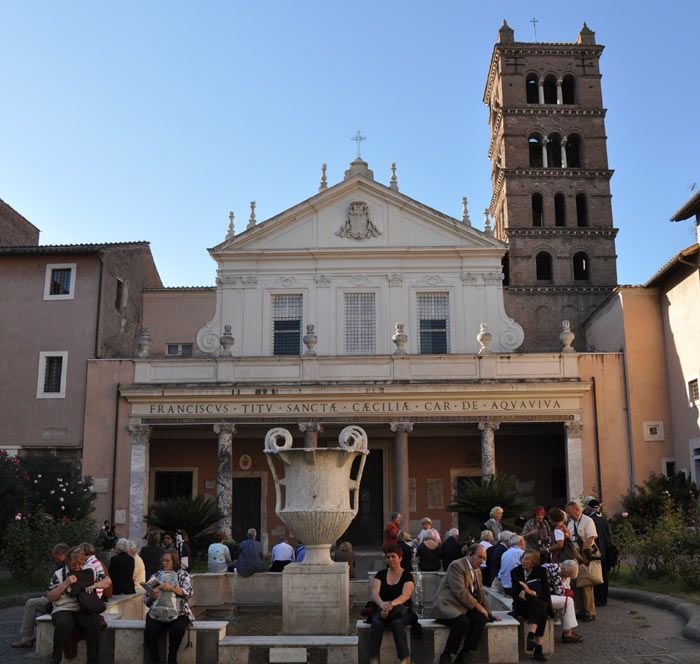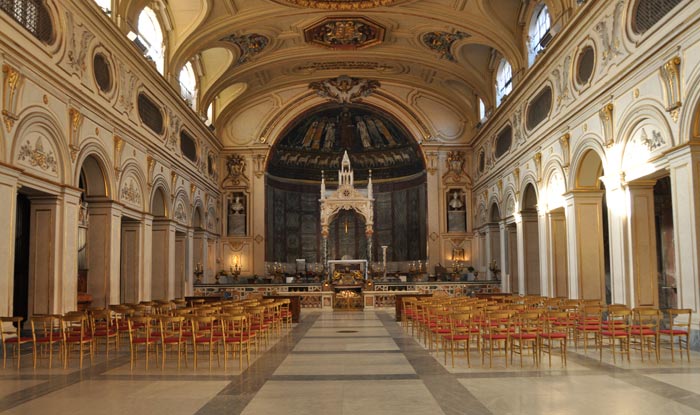Santa Cecilia in Rome; A Surprise Under the Church

Waiting to go inside.
I’m just going to say this up front; this was the last thing we did and probably my favorite experience of the trip. And it’s a little odd that it has nothing to do with food, right?
Table of Contents
Santa Cecilia Church in Rome
We arrived at Santa Cecilia to find it closed for a mid-day break.
My tip; get there when they open in the morning, or after mid-day break and head right for the crypt.
There were a couple of dozen people waiting, some clearly part of a tour group, when a nun in full habit arrived to open the locked doors to the church from within. We were there to see the crypt and headed there as soon as we entered the church.



How to get into the Santa Cecilia Crypt
The entrance is inside the tiny gift shop to the left as you go through the front doors. There is a small fee for seeing the crypt. I paid the nun and she handed me a heavy key and spoke to me in Italian. I didn’t quite understand what it was for, but I figured we had to unlock the door to enter and that I’d bring her the key right back.
History
It is said that Saint Cecilia was an aristocrat and an early Christian who was martyred in her home in AD 230. The church which stands in Trastevere today is built on top of that home, which was used in her time as a secret place of worship. The remains of a tannery can also be seen in the area beneath the church.
The first church on this site was founded in the 4th century and the present church was first built in the 9th century. Cecilia’s remains and those of her husband and his brothers were moved here from the catacombs of San Callisto. When her remains were exhumed in late 1599 during a restoration, it’s said they were perfectly preserved with clear markings from her attempted beheading. The statue of her near the altar is based on eyewitnesses of the exhumation.

Inside the Crypt
When I got to the bottom of the stairs, I found the door to the crypt was open and we were the first inside. Another couple came in shortly behind us. For a few minutes, it felt like we were alone and just discovering it for the first time. It was magical.


The chapel under the church
There were lots of little niche areas to explore. Finally, at the back of the space, I found a locked gate. Through the bars, I could see marble columns and floors and gilded mosaics on the walls, all perfectly preserved.
I finally knew why the nun had given me the key.

I unlocked the gate, left the key in the padlock, and stepped inside. It was stunning. As it turns out, this part of the crypt was built in 1899 to house the “the tombs of the martyrs Cecilia, Valerian, Tibertius, and Maximus and the popes Urban I (222-30) and Lucius I (253-54)” which were moved there in the 9th century.



We had about 2 minutes before the other couple came in and about 5 minutes before a large German tour group appeared and took their seats for a quick service. We left them singing hymns and headed back upstairs.
Inside the church of Santa Cecilia in Rome
Upstairs, the church itself is quite small with a beautifully carved statue of a sleeping St Cecilia right in front of the altar.



Other resources for more on Santa Cecilia in Trastevere Church
http://www.
Tours in Rome:




14 Comments
Naigel
This church that can be found at Rome, is really beautiful… The architecture is amazing is the art shows that best…
Lynn
Churches are one of my favorite things to tour. I vaguely remember while in Rome someone telling us that the city has 365 churches, one to tour each day of the year! The crypt of this one is absolutely stunning. Can you imagine how long it took to create those mosaics? I love seeing these off-the-beaten-path locales through your stories and beautiful photos. Again, many thanks!
Myra
The crypt under Santa Cecelia was also one my favorite experiences in Rome. Except I went down there alone (perhaps only 2-3 other tourists there) the nooks were deep in darkness, and I’ll admit it – I got the creepy-chills. It was the first time I looked for other tourists to tag along behind! Your pictures are gorgeous and bring my experience flooding back to me. Thanks for sharing.
sharon miro
the discovery of that crypt, with the key…so special. It was pretty great…and the pictures came out great!
Dave
Great discovery, and great story. There’s something to be said for being given the key to anything. Let alone finding the door it belongs too and opening it.
The Santa Cecila statue us quite unusual too.
wired2theworld
Thanks Dave. I know I’m not the first, but it was a discovery for me and that’s enough to make it special.
wandergirl
Wow – beautiful. Unfortunately I never got there during my time in Rome. What an experience, being handed the key. Saint Cecilia’s tomb is quite different too. I’ll have to mark it down for next time!
Amy
I really like the eclectic style of the building, there are so many beautiful churches in Rome. In this case, the main facade and the interior of the crypt is in baroque, but the tower (‘campanile’) has got signs from the renessaince. By the way it is a really beautiful architectural sign, it represents more than 3 different ages/styles.
jennifer
This creation is very impressive, it was truly beautiful…
Doug
Nice photos. Small bit of clarification. The statue of St. Cecilia isn’t of her sleeping. If you look closely, you can see the where the sword cut her neck…
Justin
This was a great write up – the pictures and details are much appreciated as I was trying to determine if this was worth visiting or not.
Karen
I’ve been helping my daughter research St. Cecilia for a project. We came across your site and enjoyed reading the story of your visit to the church. Pictures are so beautiful! We’ll be visiting this site in the summer and look forward to exploring. Thank you!
wired2theworld
Thank you! Glad you enjoyed it. It’s one of my favorite places in Rome.
Ron
Thank you ! Wonderful !